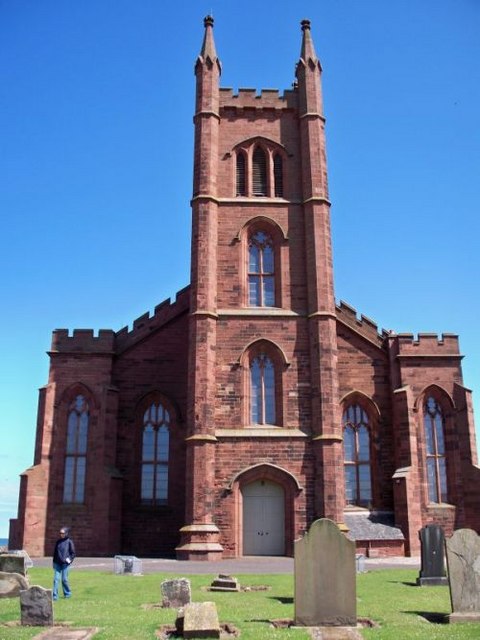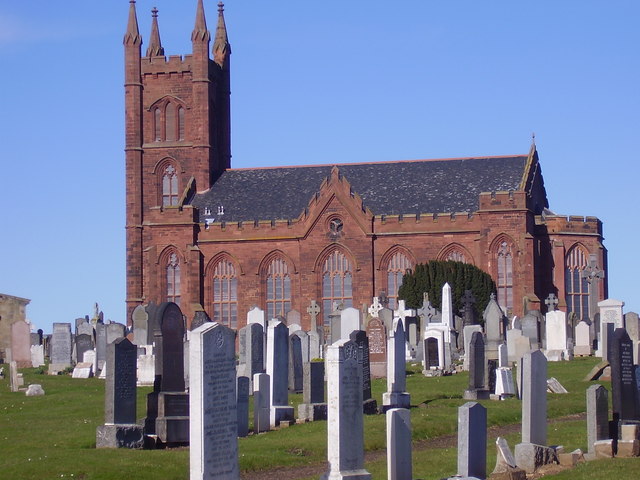Dunbar Collegiate Church on:
[Wikipedia]
[Google]
[Amazon]
 Dunbar Collegiate Church is renowned as having been the first collegiate church, in 1342, to have been established in the Lothians. The church was situated on the same site as the present-day parish church, on Queen's Road just south of
Dunbar Collegiate Church is renowned as having been the first collegiate church, in 1342, to have been established in the Lothians. The church was situated on the same site as the present-day parish church, on Queen's Road just south of
 Dunbar Collegiate Church, unlike many other chapels, churches and monasteries in the area, was spared from the over-zealous exploits of the people as they rejoiced in the popular fury, laying waste and burning anything associated with old faith. The old church became, once again, the parish church, this time of the reformed faith. Much repair and renewal work had been carried out over the years, the building looked like a hybrid of Saxon, Gothic and Norman architecture. In 1779 the church was almost totally rebuilt. Then in 1819–1821 a new church was built, and opened on 20 April 1821 with the Reverend John Jaffray the first minister at the new building. There is a magnificent monument in the church to a tireless servant of James VI and I,
Dunbar Collegiate Church, unlike many other chapels, churches and monasteries in the area, was spared from the over-zealous exploits of the people as they rejoiced in the popular fury, laying waste and burning anything associated with old faith. The old church became, once again, the parish church, this time of the reformed faith. Much repair and renewal work had been carried out over the years, the building looked like a hybrid of Saxon, Gothic and Norman architecture. In 1779 the church was almost totally rebuilt. Then in 1819–1821 a new church was built, and opened on 20 April 1821 with the Reverend John Jaffray the first minister at the new building. There is a magnificent monument in the church to a tireless servant of James VI and I,
More photos from geograph
{{coord, 55.99911, N, 2.51179, W, type:landmark_region:GB, display=title Category A listed buildings in East Lothian Churches in East Lothian Collegiate churches in Scotland Listed churches in Scotland Dunbar
 Dunbar Collegiate Church is renowned as having been the first collegiate church, in 1342, to have been established in the Lothians. The church was situated on the same site as the present-day parish church, on Queen's Road just south of
Dunbar Collegiate Church is renowned as having been the first collegiate church, in 1342, to have been established in the Lothians. The church was situated on the same site as the present-day parish church, on Queen's Road just south of Dunbar
Dunbar () is a town on the North Sea coast in East Lothian in the south-east of Scotland, approximately east of Edinburgh and from the English border north of Berwick-upon-Tweed.
Dunbar is a former royal burgh, and gave its name to an ecc ...
town centre.
History
The first mention of a church at Dunbar came in 1176 in the Taxatio ofLothian
Lothian (; sco, Lowden, Loudan, -en, -o(u)n; gd, Lodainn ) is a region of the Scottish Lowlands, lying between the southern shore of the Firth of Forth and the Lammermuir Hills and the Moorfoot Hills. The principal settlement is the Sco ...
when the church was described as ''Eclessia de Dunbar.'' This church, dedicated to St. Bega, served the parish as a whole until 1342 and its foundation as a collegiate church. On 21 April 1342, Patrick, 9th Earl of Dunbar was granted by charter, his right to the proprietorship of the church. The church would have a dean, archdean and eight prebendaries
A prebendary is a member of the Roman Catholic or Anglican clergy, a form of canon with a role in the administration of a cathedral or collegiate church. When attending services, prebendaries sit in particular seats, usually at the back of the ...
with responsibility to Dunbar, these being Spott, Belton, Pinkerton, Linton, Chirnside, Dunse, Stenton and Pitcox. The Dunbars were no strangers to the patronage of religious establishments, with the foundation of a house of Trinity friars in 1218, and then a monastery
A monastery is a building or complex of buildings comprising the domestic quarters and workplaces of monastics, monks or nuns, whether living in communities or alone (hermits). A monastery generally includes a place reserved for prayer which ...
of Carmelite monks in 1263, by the 6th and 7th earls respectively. Dunbar Collegiate continued as decreed until it became forfeit to the crown in 1435. For a while the church was 'enjoyed' by the Duke of Albany
Duke of Albany is a peerage title that has occasionally been bestowed on the younger sons in the Scottish and later the British royal family, particularly in the Houses of Stuart and Hanover.
History
The Dukedom of Albany was first granted ...
during the reign of King James III of Scotland
James III (10 July 1451/May 1452 – 11 June 1488) was King of Scots from 1460 until his death at the Battle of Sauchieburn in 1488. He inherited the throne as a child following the death of his father, King James II, at the siege of Roxburgh Ca ...
, before returning to the Dunbars. In 1483, it, once again, reverted to the crown and stayed that way until the Protestant Reformation
The Reformation (alternatively named the Protestant Reformation or the European Reformation) was a major movement within Western Christianity in 16th-century Europe that posed a religious and political challenge to the Catholic Church and in ...
in 1560.The History of Dunbar by James Miller (Dunbar)
Post Reformation
 Dunbar Collegiate Church, unlike many other chapels, churches and monasteries in the area, was spared from the over-zealous exploits of the people as they rejoiced in the popular fury, laying waste and burning anything associated with old faith. The old church became, once again, the parish church, this time of the reformed faith. Much repair and renewal work had been carried out over the years, the building looked like a hybrid of Saxon, Gothic and Norman architecture. In 1779 the church was almost totally rebuilt. Then in 1819–1821 a new church was built, and opened on 20 April 1821 with the Reverend John Jaffray the first minister at the new building. There is a magnificent monument in the church to a tireless servant of James VI and I,
Dunbar Collegiate Church, unlike many other chapels, churches and monasteries in the area, was spared from the over-zealous exploits of the people as they rejoiced in the popular fury, laying waste and burning anything associated with old faith. The old church became, once again, the parish church, this time of the reformed faith. Much repair and renewal work had been carried out over the years, the building looked like a hybrid of Saxon, Gothic and Norman architecture. In 1779 the church was almost totally rebuilt. Then in 1819–1821 a new church was built, and opened on 20 April 1821 with the Reverend John Jaffray the first minister at the new building. There is a magnificent monument in the church to a tireless servant of James VI and I, George Hume, 1st Earl of Dunbar
George Home, 1st Earl of Dunbar, Order of the Garter, KG, Privy Council of the United Kingdom, PC (ca. 155620 January 1611) was, in the last decade of his life, the most prominent and most influential Scotsman in England. His work lay in the King ...
(1556-1611), High Treasurer of Scotland
The Treasurer was a senior post in the pre-Act of Union 1707, Union government of Scotland, the Privy Council of Scotland.
Lord Treasurer
The full title of the post was ''Lord High Treasurer, Comptroller, Collector-General and Treasurer of the Ne ...
and Chancellor of the Exchequer
The chancellor of the Exchequer, often abbreviated to chancellor, is a senior minister of the Crown within the Government of the United Kingdom, and head of His Majesty's Treasury. As one of the four Great Offices of State, the Chancellor is ...
of England.
Noted Cleric
Columba de Dunbar
Columba de Dunbar ( 1386 – 1435) was Bishop of Moray from 1422 until his death at Spynie Palace near Elgin sometime before 7 November 1435.
Columba was "of Royal race", the third "lawful son of George de Dunbar, 10th Earl of March" and his ...
became dean of the Collegiate Church in 1412 before taking up at the post of Bishop of Moray
The Bishop of Moray or Bishop of Elgin was the ecclesiastical head of the Diocese of Moray in northern Scotland, one of Scotland's 13 medieval bishoprics. If the foundation charter of the monastery at Scone is reliable, then the Bishopric of Moray ...
at Elgin Cathedral
Elgin Cathedral is a historic ruin in Elgin, Moray, north-east Scotland. The cathedral—dedicated to the Holy Trinity—was established in 1224 on land granted by King Alexander II outside the burgh of Elgin and close to the River Lossie. I ...
where he died in 1435. He is buried in the Dunbar Aisle at the great cathedral. Hooper family site
See also
*List of places in East Lothian
''Map of places in East Lothian compiled from this list''
The List of places in East Lothian is a list for any town, village, hamlet, castle, golf course, historic house, hill fort, lighthouse, nature reserve, reservoir, river, and other place of ...
*List of collegiate churches in Scotland
Bothwell Parish is the only Collegiate church where worship is still held. It is thought that the first ''Collegium'' of canons with its own chapel was formed in St. Andrews in the 13th century, and it is thought that by the Reformation there w ...
References
External links
More photos from geograph
{{coord, 55.99911, N, 2.51179, W, type:landmark_region:GB, display=title Category A listed buildings in East Lothian Churches in East Lothian Collegiate churches in Scotland Listed churches in Scotland Dunbar